Flower gardening for beginners is an enjoyable and colorful hobby that can be pursued with the right guidance and practice. Whether you are looking to add some fresh blooms to your home or create beautiful bouquets for loved ones, flower gardening is a rewarding and relaxing pastime.
If you are new to gardening, don’t worry! With a little planning and effort, you can learn the basics of flower gardening and start growing beautiful flowers in no time. This beginner-friendly guide will provide you with all the information you need to get started on your flower gardening journey.
Key Takeaways:
- Flower gardening is an enjoyable and colorful hobby for beginners.
- The right guidance and practice are essential for success.
- This beginner-friendly guide provides all the information you need to plan, cultivate, tend, harvest, and arrange your own home-grown flowers.
Understanding Common Gardening Terms for Beginners
To start, beginners should understand common gardening terms, have essential tools on hand, and know the answers to frequently asked questions. Flower gardening can seem overwhelming at first, with a vocabulary all its own. Here are some basic terms to help you cultivate a better understanding of flower gardening fundamentals:
| Term | Definition |
|---|---|
| Annuals | Plants that complete their life cycle in one growing season and do not return the following year. |
| Biennials | Plants that take two growing seasons to complete their life cycle. |
| Deadheading | The process of removing spent flowers to encourage new growth and prolong blooming. |
| Fertilizer | A substance added to soil or plants to promote growth and health. |
| Hardiness zone | An area defined by the USDA based on average annual minimum temperature; used to determine the suitability of plants for a particular location. |
| Perennials | Plants that return year after year without replanting. |
| Propagation | The process of reproducing plants through seed, cuttings, or other methods. |
| Soil pH | A measure of the acidity or alkalinity of soil, ranging from 0 to 14; most plants prefer a slightly acidic soil pH between 6 and 7. |
| Sun exposure | The amount of direct sunlight a plant receives daily. |
These terms are just the beginning of your flower gardening education. While you don’t need to know every term to get started, having a basic understanding of common gardening language will help you navigate the world of flower gardening with more confidence.
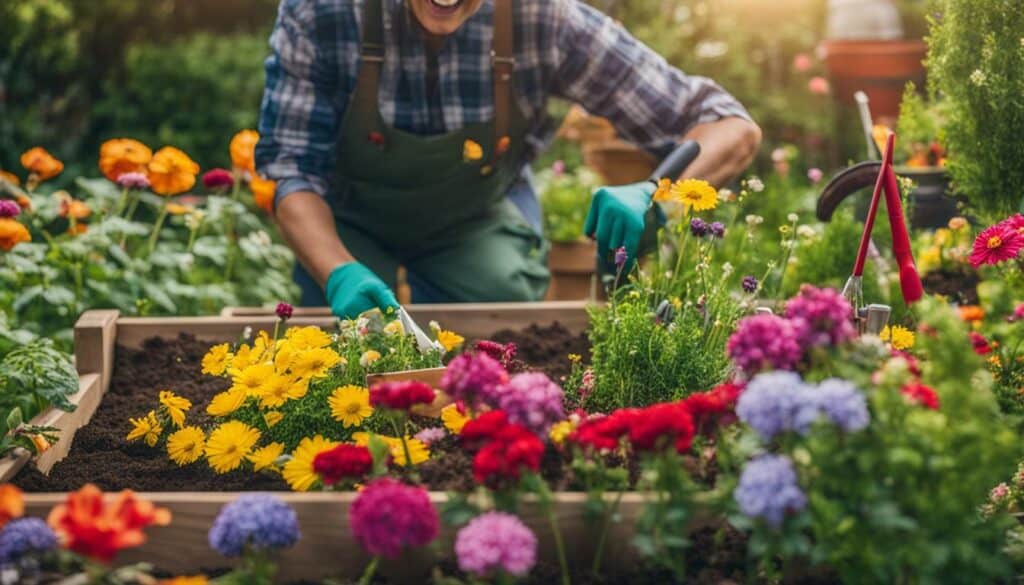
Choosing the Best Spot for Your Flower Garden
It is important to choose the best spot in the yard based on the local climate and ensure access to a water source. When selecting the location for your flower garden, there are several factors to consider for successful flower growth.
| Sunlight exposure | Most flowers require at least six hours of sunlight daily, so choose an area that receives sufficient sunlight. |
|---|---|
| Soil drainage | Ensure the soil is well-draining and avoid low-lying areas prone to flooding during heavy rains. |
| Water source | Having access to a water source or an easily accessible water hose is also essential. |
Starting with a small garden and gradually expanding as you gain more experience is recommended. Preparing the soil is crucial for the health of your plants. Remove any weeds, rocks, debris, and sod from the garden area, and loosen up the soil by aerating and breaking up clumps.
Conduct a soil test to determine the nutrient and pH levels and add amendments like compost or leaf litter to improve soil quality. When selecting plants, consider their sun and soil requirements, and ensure they are suitable for your gardening zone. Timing is also important when planting flowers, as they need to be acclimated to outdoor conditions and planted after the last frost date.
Proper watering techniques include watering deeply and less frequently, avoiding watering the foliage, and watering during cooler morning temperatures. Regular maintenance, such as weeding and deadheading spent flowers, is necessary to keep the garden looking clean and healthy.
By following these guidelines, you can create a vibrant and thriving flower garden. Starting a flower garden for beginners can be an exciting and rewarding experience, and with the right location, soil preparation, plant selection, and maintenance, you can enjoy a colorful and fragrant outdoor space.
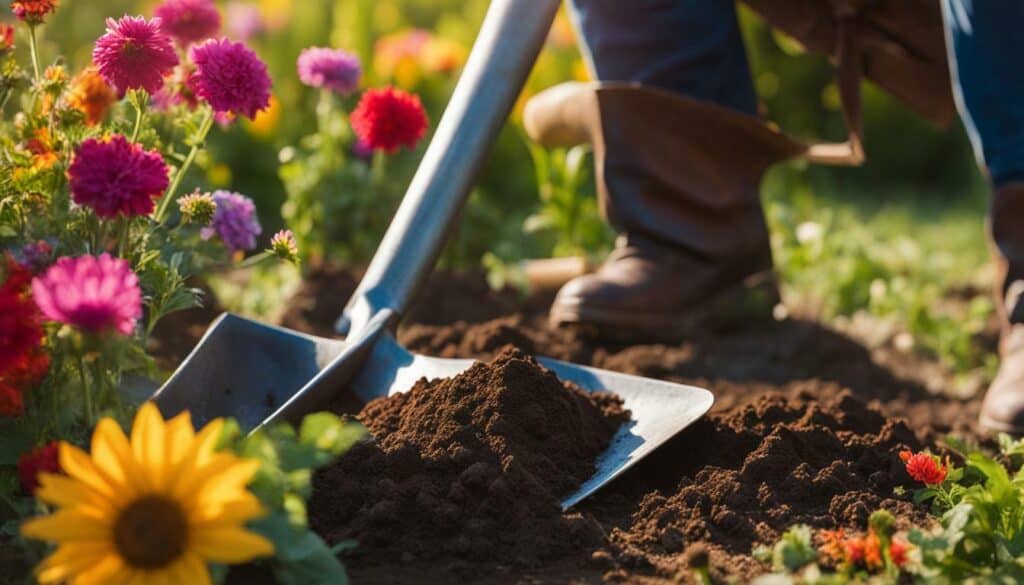
Preparing the Soil for Successful Flower Gardening
Soil preparation is crucial for successful flower gardening, starting with removing weeds, rocks, debris, and sod from the garden area. Choose a location that receives at least six hours of sunlight daily and has well-draining soil. Loosen up the soil by aerating and breaking up clumps so that plant roots can easily penetrate the soil.
Perform a soil test to check nutrient and pH levels. This will help you determine the type of organic matter and amendments you need to add to the soil. Compost or leaf litter can improve soil structure, as well as provide nutrients for the plants. Level the surface of the soil and then choose plants that will thrive in your specific environment, considering sunlight requirements and soil conditions.
| Beginner Flower Gardening Tips |
|---|
| Plant at the appropriate time: Take into account the last frost date in your area. Planting too early or too late can harm the plants. |
| Proper watering: Proper watering is crucial, and it is best to water deeply and less frequently to encourage deep root growth. |
| Mulching and Deadheading: Mulching around plants can help control weeds and retain soil moisture. Deadheading spent flowers will keep the garden looking neat and encourage more blooms throughout the season. |
Understanding gardening zones, plant types (perennials, annuals, biennials), and sun levels are also important factors in successful flower gardening. With proper soil preparation and care, your flower garden can flourish and bring you joy for many seasons to come.
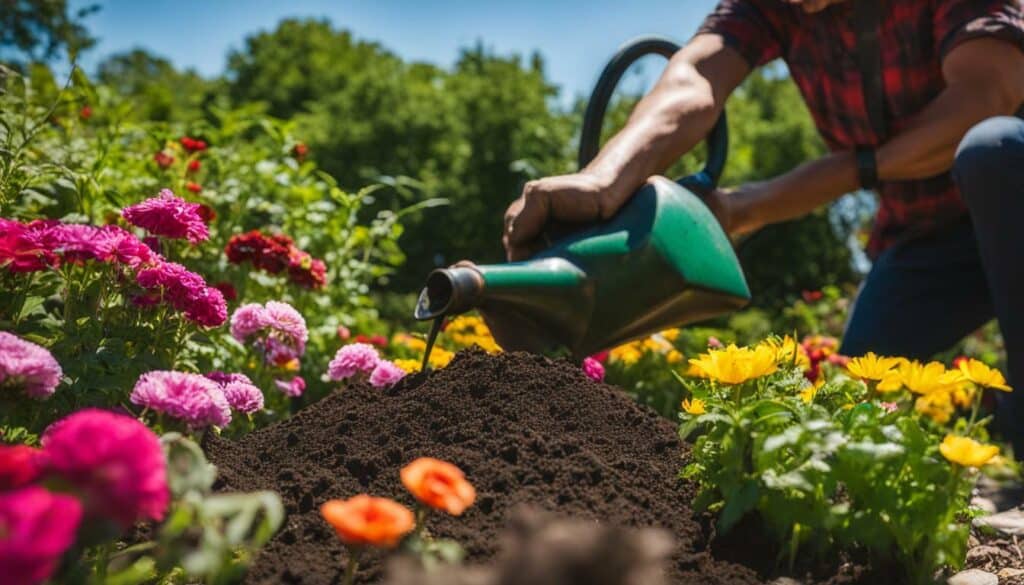
Selecting the Right Plants for Your Flower Garden
Selecting the right plants for the garden based on sunlight exposure and soil conditions is essential. As a beginner, it is important to choose plants that are easy to grow and maintain. Some of the best flowers for beginner gardeners include marigolds, zinnias, and sunflowers. These plants are hardy and can tolerate a range of soil types and sunlight levels. Another great option is to choose native plants that are adapted to your local climate. They are often easier to grow and require less maintenance.
When selecting plants, it is important to consider your gardening zone, the type of plants, and the sun levels in your garden. Your gardening zone determines which plants are suitable for the climate in your area. You can find your gardening zone by searching online or using a zone map. Perennial plants are a great choice as they come back year after year. They are also low-maintenance and require less replanting. Annual plants grow and bloom in the same year they are planted, making them perfect for adding bursts of color to your garden. Biennial plants come back every other year and require a bit more planning.
Sun levels are also important to consider when selecting plants. Some plants need full sun, while others thrive in partial shade. Make sure to choose plants that are suited to the sun levels in your garden. For example, if you have a shady area, choose plants that thrive in partial or full shade such as impatiens or begonias. If your garden gets a lot of sun, choose plants like petunias or geraniums that can tolerate full sun.
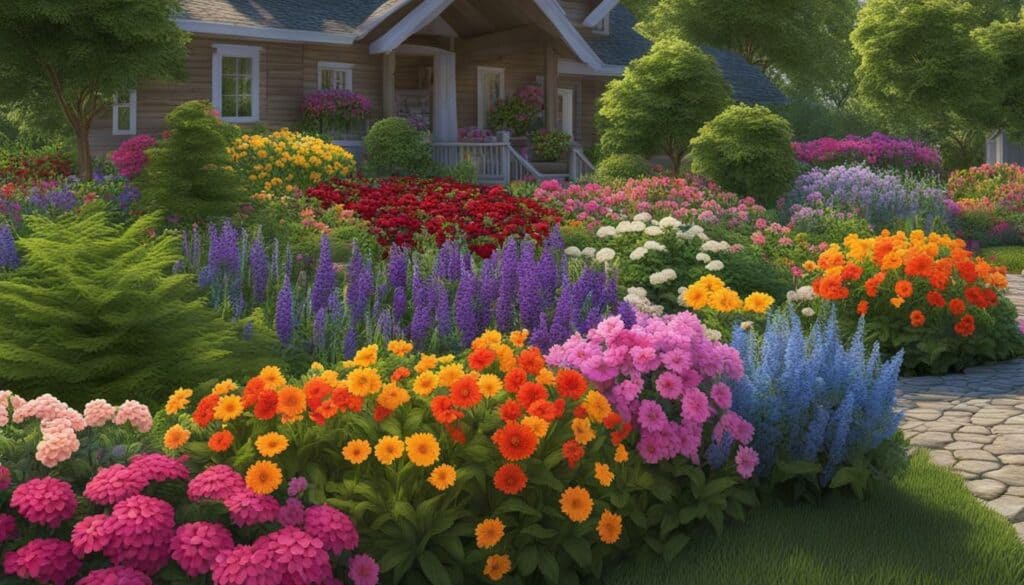
Incorporating a mix of different plants with varying sun and water needs can create a visually interesting and diverse garden. Don’t be afraid to experiment and try new plants, but make sure to research their growing needs before planting. By selecting the right plants for your garden, you will ensure that your flower garden thrives and brings joy throughout the growing season.
Essential Tips for Watering Your Flowers
Proper watering techniques should be followed to ensure the health and growth of your flowers. It is always better to water deeply and less frequently to encourage deep root growth, making your plants more resilient to drought.
When watering, pay attention to where the water goes. Water the soil directly at the base of the plants, avoiding the foliage. This will help prevent diseases such as mildew and leaf rot, which can occur when water sits on the leaves.
To prevent loss of essential nutrients, use a soaker hose or a slow trickle watering system at the base of the plants. This will also prevent runoff and water wastage.
Watering your plants in the morning is best as the cooler temperatures will reduce stress from heat and intense sunlight. The soil retains more moisture in the mornings, keeping your plants hydrated for longer.
It’s crucial to regularly check the moisture level of the soil. Insert your finger 3-4 inches below the surface, and if it feels dry, it’s time to water. If it feels moist, hold off as overwatering can be just as detrimental to the health of your plants as under watering.
| Tip | Description |
|---|---|
| Deep watering | Water your plants deeply and less frequently to encourage deep root growth, making plants more resilient to drought. |
| Watering the soil | Watering the soil directly at the base of the plants helps avoid diseases like mildew and leaf rot, which can occur when the foliage gets wet. |
| Use a soaker hose or slow trickle | To prevent runoff and loss of essential nutrients, use a soaker hose or slow trickle watering system at the base of the plants. |
| Water in the morning | Water your plants during the cooler morning temperatures to reduce stress from heat and intense sunlight. The soil retains more moisture in the mornings, keeping your plants hydrated longer. |
| Check soil moisture | Regularly check the soil moisture level by sticking your finger 3-4 inches below the surface. If it feels dry, it’s time to water; if it feels moist, hold off. |
By following these essential watering tips, you can ensure the health and vitality of your flower garden. Remember to adjust watering based on weather conditions and the specific needs of your plants.
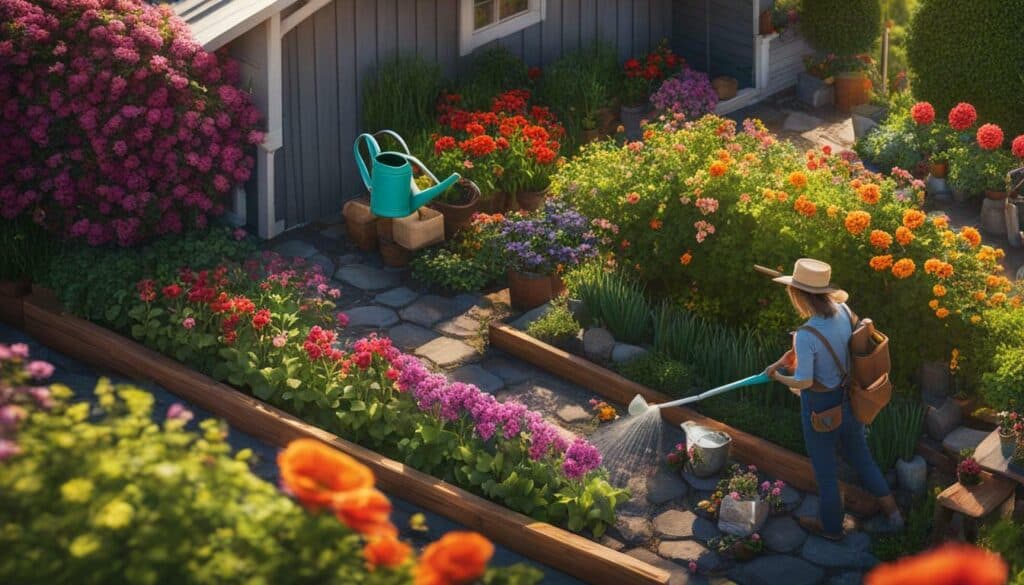
Maintaining Your Flower Garden
Maintaining the flower garden includes weeding garden beds and deadheading spent flowers. It’s essential to keep up with these tasks to promote healthy growth and maintain the appearance of your garden. One way to make weeding easier is to keep up with it regularly, pulling weeds as soon as you see them.
Deadheading, or removing spent flowers, encourages the plant to produce more blooms and prevents it from using energy to produce seeds. Cut the flower stem back to a leaf node just above a set of leaves or buds.
Understanding your gardening zone is also important when maintaining your flower garden. Your zone can determine which plants will thrive in your area. Perennial plants, which come back year after year, and annuals, which need to be replanted each year, are common choices for flower gardens. It’s also crucial to consider the amount of sunlight your garden receives, as some plants require full sun while others thrive in partial shade.
Proper soil preparation is another key aspect of maintaining a healthy flower garden. This involves removing weeds, rocks, and debris, aerating the soil, and adding organic matter. Adding compost or other organic matter to your soil can improve soil quality, retain moisture, and reduce erosion.
Watering your flower garden deeply and less frequently promotes deep root growth and helps your plants endure periods of drought. It’s best to water in the morning to allow the soil to retain moisture and to avoid watering foliage, which can promote the spread of disease.
Regular weeding and deadheading of spent flowers are important for maintaining the appearance and health of your garden. By following these tips, you can successfully maintain a beautiful flower garden.
Understanding Gardening Zones and Plant Types
Understanding gardening zones, plant types (perennials, annuals, and biennials), and sun requirements is also essential for successful flower gardening. Each plant has its own needs, and by understanding these factors, gardeners can choose the right plants for their gardens.
Gardening zones are determined by the USDA and help determine which plants will thrive in different regions across the United States. Each zone represents a 10-degree temperature difference, with Zone 1 being the coldest and Zone 12 being the warmest. Knowing your gardening zone is important because it helps you choose plants that will survive and thrive in your climate. It’s especially important when doing research or purchasing plants online, as certain plants may not be suitable for your region.
Perennial plants come back year after year, while annual plants only last for one season and need to be replanted. Biennial plants come back every other year. Understanding the different types of plants and their life cycles is key to planning your garden. By mixing annuals and perennials, gardeners can ensure a constant display of color throughout the growing season.
Additionally, it’s essential to understand the sun requirements of plants. Some plants require full sun, while others can thrive in partial shade. Knowing the sun levels in your garden will help you choose the right plants for each area. For example, if you have a shaded area, you can choose shade-loving plants like impatiens or ferns. On the other hand, if you have a sunny area, you can choose sun-loving plants like marigolds or zinnias.
By understanding gardening zones, plant types, and sun requirements, you can create a beautiful and successful garden. Consider the different factors when selecting plants for your garden, and you’ll be well on your way to a flourishing garden that will be the envy of all your neighbors.

Conclusion
In conclusion, flower gardening for beginners is an enjoyable and colorful hobby that can be pursued with the right guidance and practice. By following a step-by-step flower gardening guide and understanding the basics of gardening zones, plant types, and sun requirements, beginners can create a beautiful and thriving flower garden.
Gardening Zones
Knowing your gardening zone is essential for successful flower gardening. It helps you choose plants that can thrive in your climate, reducing the risk of plant failure. There are 11 gardening zones in the United States, each with its unique climate conditions. You can determine your gardening zone by using the USDA Plant Hardiness Zone Map, which is available online.
Plant Types
Understanding the different types of plants is crucial for selecting the right plants for your flower garden. Perennials, annuals, and biennials are the three main types of plants. Perennials are plants that live for several years, while annuals complete their life cycle within a year. Biennials take two years to complete their life cycle. Knowing the life cycle of your plants can help you plan and care for your flower garden accordingly.
Sun Requirements
Paying attention to the sun requirements of your plants is crucial for their growth and development. Some plants thrive in full sun, while others prefer partial shade. Make sure to choose plants that match the sun exposure in your flower garden.
By following these tips and guidelines, beginners can achieve success in flower gardening. With a little patience and practice, you can create a beautiful and thriving flower garden that will bring joy and color to your home. Happy gardening!
FAQ
Q: What is flower gardening?
A: Flower gardening is a hobby that involves planning, cultivating, tending, harvesting, and arranging home-grown flowers.
Q: How do I start flower gardening as a beginner?
A: To start flower gardening as a beginner, it is important to understand common gardening terms, have essential tools on hand, and know the answers to frequently asked questions.
Q: What is the best spot in my yard for a flower garden?
A: The best spot for a flower garden in your yard is one that has the right local climate and access to a water source. Choose a location that receives enough sunlight and is easily accessible for watering and maintenance.
Q: How do I prepare the soil for successful flower gardening?
A: To prepare the soil for successful flower gardening, start by removing weeds, rocks, debris, and sod from the garden area. Then, loosen up the soil, perform a soil test, and add organic matter like compost or leaf litter to improve soil quality.
Q: How do I select the right plants for my flower garden?
A: When selecting plants for your flower garden, consider sunlight exposure and soil conditions. Choose flowers that thrive in your specific conditions and make sure to plant them at the appropriate time. Acclimate plants to outdoor conditions before planting them in the garden.
Q: What are some essential tips for watering my flowers?
A: When watering your flowers, it is important to water deeply and less frequently, avoid watering foliage, and choose cooler morning temperatures for watering. These techniques will help ensure proper hydration for your plants.
Q: How do I maintain my flower garden?
A: Maintaining a flower garden involves regularly weeding garden beds and deadheading spent flowers. It is also important to understand gardening zones, plant types, and sun requirements for successful flower gardening.
Q: What are gardening zones and plant types?
A: Gardening zones refer to specific geographic regions that have similar climate conditions. Plant types include perennials, annuals, and biennials, each with their own characteristics and growing requirements. Understanding these concepts will help you choose the right plants for your flower garden.
Can the Garden Guides Help Me Start Flower Gardening as a Beginner?
Can the green thumb garden guides help me start flower gardening as a beginner? These comprehensive guides are designed to assist novice gardeners in mastering the art of growing beautiful flowers. From selecting the right type of flowers to nurturing them with essential tips and techniques, the green thumb garden guides provide invaluable advice and knowledge to kickstart your flower gardening journey. Discover the joys of cultivating a colorful and thriving garden with the assistance of these helpful guides.
Source Links
- https://shiplapandshells.com/beginners-guide-to-flower-gardening/
- https://www.prettypurpledoor.com/flower-gardening-for-beginners/
- https://www.amazon.com/Flower-Gardening-Beginners-Maintaining-Cut-Flower/dp/1685391052
- https://www.amazon.com/Flower-Gardening-Beginners-Essential-Landscape/dp/B09FWNWDJZ
- https://davesgarden.com/guides/articles/gardening-terms-for-beginners
- https://www.allrecipes.com/article/beginners-guide-to-common-gardening-terms/
- https://www.gardenary.com/blog/a-beginner-s-guide-to-common-gardening-terms
- https://www.marthastewart.com/8248515/how-start-flower-garden
- https://www.provenwinners.com/learn/make-your-bed
- https://www.longfield-gardens.com/article/new-to-flower-gardening-heres-where-to-start
- https://www.almanac.com/soil-preparation-how-do-you-prepare-garden-soil-planting
- https://www.gardendesign.com/flowers/easy.html
- https://greengardencottage.com/how-to-water-flowers/
- https://greengardencottage.com/beginners-guide-to-flower-gardening/
- https://www.realsimple.com/usda-gardening-zones-7503739
- https://www.bhg.com/gardening/gardening-by-region/how-to-use-hardiness-zone-information/
- https://www.asiafarming.com/how-to-create-productive-flower-garden-a-complete-guide-for-beginners
- https://www.agrifarming.in/flower-gardening-for-beginners-tips-and-ideas

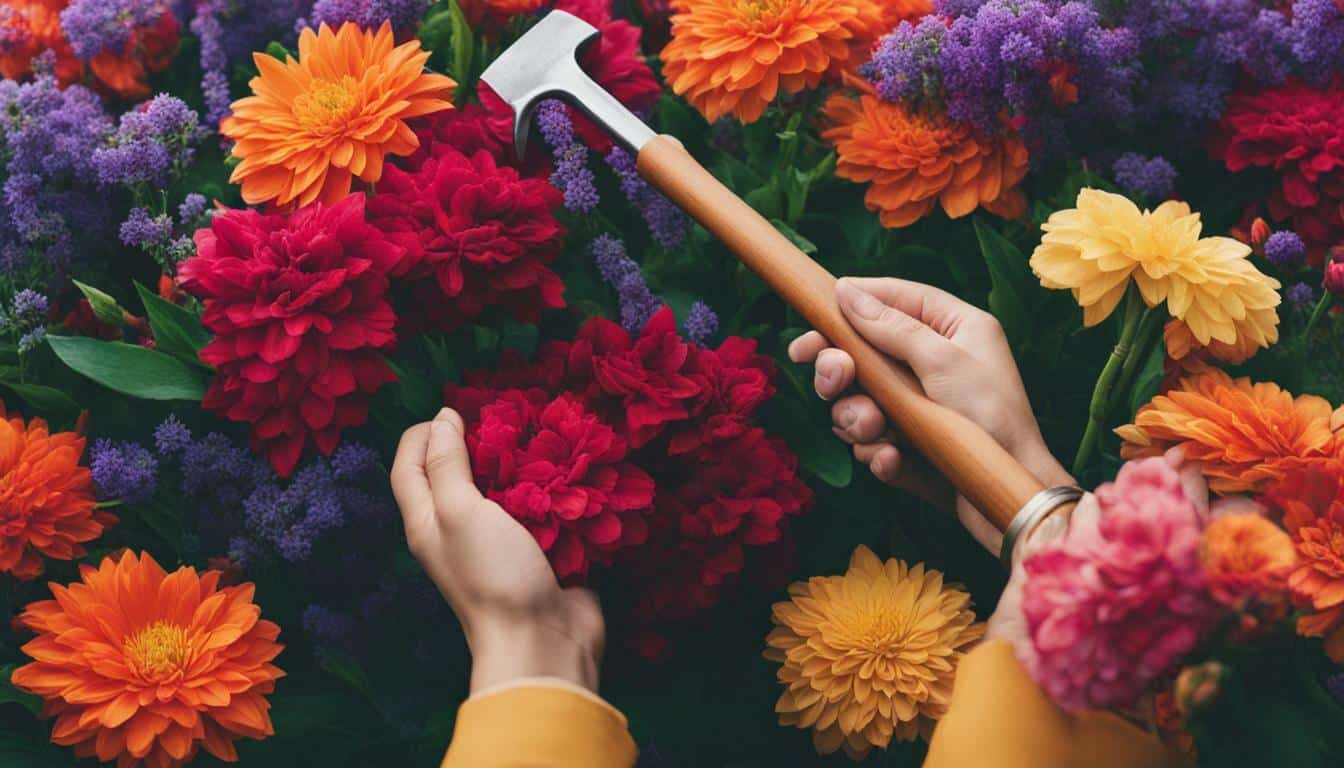



Leave a Reply